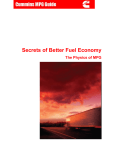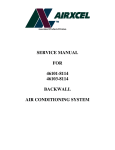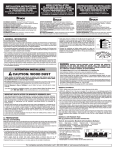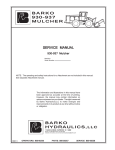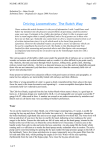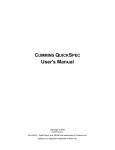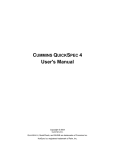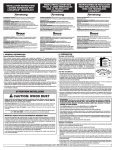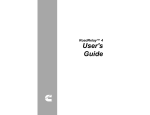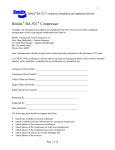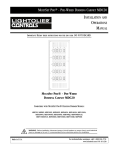Download Cummins Reveals Secrets to Great MPG
Transcript
in association with Secrets of Better Fuel Economy The Physics of MPG Contents Introduction: Understanding Fuel Economy ........................................................................... 4 Rock-Solid Rules................................................................................................................ 4 Vehicle Power Requirements ................................................................................................. 5 Aerodynamic Drag.............................................................................................................. 5 Cab Aerodynamic Considerations...................................................................................... 9 Tractor-Trailer Air Gap ..................................................................................................... 10 Trailer Body Aerodynamics .............................................................................................. 11 Engine Accessory/Drivetrain Losses................................................................................ 11 Gearing............................................................................................................................. 12 Lubricants......................................................................................................................... 13 Tire Rolling Resistance .................................................................................................... 15 Engine Operation and Maintenance ..................................................................................... 18 Engine Operating Temperature (Coolant and Lube Oil) .................................................. 18 Intake and Exhaust Restriction......................................................................................... 18 Fuel Line Restriction......................................................................................................... 18 Aftertreatment Regeneration............................................................................................ 19 Air Compressor Operation................................................................................................ 20 Engine Lube Oil Levels .................................................................................................... 21 Fan Operation .................................................................................................................. 21 Freon Compressor Operation........................................................................................... 21 Axle Alignment ................................................................................................................. 22 Secrets of Better Fuel Economy Page 2 of 37 Tire Inflation Pressure ...................................................................................................... 23 Powertrain Guidelines ...................................................................................................... 24 Standard Heavy-Duty Gearing Recommendations .......................................................... 24 Vehicle Operating Techniques.............................................................................................. 25 Efficient Driving Behavior ................................................................................................. 26 Pre-Trip Inspection ........................................................................................................... 27 Road Surface ................................................................................................................... 27 Shifting Techniques.......................................................................................................... 28 Engine Idling..................................................................................................................... 30 Auxiliary Power Unit (APU).................................................................................................. 30 Weather and Seasonal Conditions ...................................................................................... 30 Ambient Temperature....................................................................................................... 31 Wind ................................................................................................................................. 31 Rain and Snow ................................................................................................................. 31 Fuel Blends ...................................................................................................................... 32 Appendix A: Customer MPG Effect Worksheet .................................................................... 33 Appendix B: General Information on Fuel Consumption ...................................................... 34 Appendix C: Effects of First Fill............................................................................................. 36 Secrets of Better Fuel Economy Page 3 of 37 Introduction: Understanding Fuel Economy The importance of fuel economy to the successful operation of a trucking company cannot be understated. Fuel is one of the largest variable costs in a trucking venture.. While no trucking operation can control the cost of fuel; it has at least some control over the amount or rate of consumption. Rock-Solid Rules Every 2% reduction in aerodynamic drag results in approximately 1% improvement in fuel economy. Above 55 mph, each 1 mph increase in vehicle speed decreases fuel economy by 0.1 MPG. Worn tires provide up to 7% better fuel economy than new tires. Used lug drive tires can get up to 0.4 MPG better fuel economy than new lug tires. Ribbed tires on the drive axles provide 2–4% better fuel economy than lugged tires. Every 10 psi that a truck’s tires are underinflated reduces fuel economy by 1%. The break-in period for tires is between 35,000 and 50,000 miles. Tires make biggest difference in MPG below 50 mph; aerodynamics is the most important factor over 50 mph. The most efficient drivers get about 30% better fuel economy than the least efficient drivers. Idle time is costly. Every hour of idle time in a long-haul operation can decrease fuel economy by 1% because you’re burning fuel and not moving. Secrets of Better Fuel Economy Page 4 of 37 Vehicle Power Requirements In the simplest of terms, you burn fuel to make horsepower, and you use horsepower to overcome all of the forces that are trying to retard, or hold back, the truck. So, a truck that rolls down the road with minimum drag will use less horsepower and consume less fuel. The power required to maintain a given road speed depends on the sum of the following forces: Aerodynamic Drag Grade Resistance Tire Rolling Resistance Engine Accessory/Drivetrain losses This section reviews these items in detail to demonstrate the impact of each on fuel savings. Aerodynamic Drag Aerodynamic drag is the result of forces (pressure imbalances) acting on a vehicle as it passes through the air. The magnitude of the forces acting on a vehicle depends on speed, frontal area and external shape. Aerodynamic drag is the most significant contributor to vehicle power requirements above a speed of 50 mph. As the following graph shows, aerodynamic aids can have a major impact on vehicle fuel economy on an interstate duty cycle and very little impact on an intercity duty cycle. 14 % MPG Gain 12 10 8 6 4 2 0 0 5 10 15 20 % Aerodynamic Aid Interstate Secrets of Better Fuel Economy Intercity Rural Delivery Urban Delivery Page 5 of 37 No Aerodynamic Treatment In this case, 264 horsepower is needed to overcome all of the forces acting on the truck and to keep it rolling at 65 mph. Aerodynamic forces (wind resistance) account for 145 hp (over half) of the power demand. Level Road Power Requirements AERO = 145 HP TIRE = 87 HP MISC = 32 HP 264 HP POWER REQUIREMENTS @ 65 MPH POWER OUTPUT (HP) 500 ENGINE RPM 1450 @65 MPH 400 GCW = 80000 lb 300 264 HP 200 100 0 0 10 20 30 40 50 60 70 80 90 ROAD SPEED (MPH) Rock-Solid Rule Tires make biggest difference in MPG below 50 mph; aerodynamics is the most important factor over 50 mph. Secrets of Better Fuel Economy Page 6 of 37 Full Aerodynamic Treatment At 65 mph, aerodynamic treatments can reduce the horsepower required to move the truck by 30 to 35 horsepower. Notice in this example that a vehicle equipped to reduce air resistance also reduces power output from 145 hp to 113 hp, a reduction of 22%. Level Road Power Requirements AERO = 113 HP TIRE = 87 HP MISC = 32 HP 230 HP POWER REQUIREMENTS @ 65 MPH POWER OUTPUT (HP) 500 ENGINE RPM 1450 @65 MPH 400 GCW = 80000 lb 300 230 HP 200 100 0 0 10 20 30 40 50 60 70 80 90 ROAD SPEED (MPH) Notice that these aerodynamic treatments are more effective at higher speeds as represented by the increased vertical depth of the red graph above. Also notice that the power required to overcome things like tire rolling resistance are not affected by the aerodynamic aids. Secrets of Better Fuel Economy Page 7 of 37 The following graph shows how the impact of aerodynamic treatments depends on speed. For trucks in pickup and delivery operations in urban areas, the cost and maintenance of aerodynamic treatments may outweigh the benefits. However, for an over-the-road (OTR) tractor and trailer, the fuel savings from aerodynamic treatments may quickly offset the higher initial purchase price of the equipment. Power Requirement (Bhp) Aerodynamic Power Requirements 400 360 320 280 240 200 160 120 80 40 No Air Aids Full Air Aids 50 55 60 65 70 75 80 85 90 Vehicle Speed (MPH) At approximately 0.3 lb./BhpHr fuel consumption, a reduction of 32 Bhp required to cruise at 65 mph results in a savings of about 9.6 lbs. of fuel every hour (0.3 x 32 = 9.6). Since diesel fuel weighs about 7.1 lb./gal., this amounts to a savings of 1.35 gallons of fuel saved every hour (9.6/7.1 = 1.35). For a truck running 10 hours per day, that’s 13.5 gallons of fuel saved per day. At $2.45 per gallon of fuel, the dollar savings is $33.12 per truck per day. Table 1: Comparison of Treatments No Aerodynamic Treatment Full Aerodynamic Treatment MPG advantage assuming 250 hp road load Secrets of Better Fuel Economy Aerodynamic Power Requirement (hp) 145 113 32 (hp difference) ~ 13% better MPG Page 8 of 37 Cab Aerodynamic Considerations Not every truck has to be fitted with all of the aerodynamic features available. The list here shows some of the items that can improve aerodynamic efficiency. Trailer type and loads hauled, in addition to the vehicle speed, will determine the effectiveness of a particular item. Curved Windshield Full Roof Deflector Aero Mirrors Fairings Side Extenders Sloped Hood Side Skirts Round Corners Under Hood Air Cleaner(s) Aero Bumper Concealed Exhaust System Air Dam Recessed Door Hinges Aero Headlights Grab Handles Slanted Windshield Worse Fuel Economy Better Fuel Economy Secrets of Better Fuel Economy Page 9 of 37 Tractor-Trailer Air Gap To minimize drag resulting from crosswinds and turbulent air, tractor-trailer gaps should be minimized or aeroskirts should be used to smooth the airflow. Beyond approximately 30 inches, every 10-inch increase in tractor-trailer air gap increases aerodynamic drag by approximately 2%. If axle weights allow, slide the fifth wheel forward to minimize the gap and reduce wind resistance. Rock-Solid Rule Every 2% reduction in aerodynamic drag results in approximately 1% improvement in fuel economy. Secrets of Better Fuel Economy Page 10 of 37 Trailer Body Aerodynamics Drag characteristics of miscellaneous trailer configurations and body styles can vary, and therefore will impact fuel economy. A straight-side van trailer with rounded corners at the front offers the least resistance. Table 2: Common Trailer Bodies Exhibiting Higher Drag % Increase in Aerodynamic Drag Single Trailers Square corner/vertical rib van Flatbed with irregularly shaped loads Cattle haulers Car haulers 5-10 (-2.5% to 5% MPG) 10-30 (-5% to 15% MPG) 10-30 10-30 Double/Triple Trailers Doubles Triples 10 15 Engine Accessory/Drivetrain Losses Although largely fixed, engine accessory and drivetrain losses can significantly contribute to total vehicle power requirements. Engine accessories consist of: Cooling fan Freon compressor Air compressor Alternator Power steering Drivetrain consists of: Oil Windage/Churning Frictional losses Secrets of Better Fuel Economy Page 11 of 37 Gearing The rpm level where the engine cruises can provide critical fine-tuning of fuel economy. To do this, you can spec the gearing so that the engine runs at the ideal rpm. Every engine is a bit different, so the ideal rpm for one engine isn't the same for another. To find the gearing recommendations for Cummins engines, use Cummins PowerSpec®, available at www.powerspec.cummins.com, to calculate the engine rpm for a given cruising speed based on transmission gearing, axle gearing and tire size. This makes finding the ideal gearing almost effortless. The startability value represents the maximum grade on which the vehicle can be put into motion without using the accelerator when loaded to the specified vehicle weight using the lowest transmission gear ratio. While the transmission top gear ratio determines cruise rpm, startability is determined by the transmission's first or low gear ratio. This may not seem important for an OTR tractor, where only a few interstates have grades in excess of 7%, but pulling away from a loading dock can test the startability of a tractor under adverse circumstances. The power required to move the vehicle increases depending on the vehicle weight and the steepness of the grade. Gradeability is the vehicle's ability to climb a grade at a given speed. For example, a truck with a gradeability of 4% at 65 mph can maintain 65 mph on a 4% grade. Any steeper grade will cause a reduction in vehicle speed while climbing the hill. Gradeability at peak torque comes into play when climbing the hills. Some drivers’ first response is to downshift into lower gears as they start to ascend the hills. Letting the engine RPM approach peak torque before downshifting will get you over the hill faster and with less fuel consumed. If you spec too much horsepower, you encourage drivers to accelerate rapidly and drive faster, but spec’ing too little horsepower reduces gradeability and creates driver dissatisfaction. Effects of First Fill Recording the first fuel fill before the truck runs any miles will give a false MPG from the onset. See Appendix C for a table that lists how the recorded MPG will vary from the actual MPG. Notice the mileage needed to correct this difference is over 140,000 miles! Secrets of Better Fuel Economy Page 12 of 37 Lubricants While the efficiency of drivetrain components is largely fixed by design, gross efficiency losses can be minimized through proper selection of lubricants. Synthetic base lubricants are manufactured in the laboratory to exhibit superior high temperature stability and low temperature fluidity. Since these fluids are created to exhibit less thickening at low temperatures, pumping losses are reduced and substantial reductions in spin losses can be realized at low operating temperatures. Test results indicate no significant difference in engine efficiency between synthetic and mineral base lube oils at normal operating temperatures. Since the synthetics are more expensive and, in an engine crankcase, are subject to the same contaminants as mineralbased oils, they may not be cost effective. All oils thicken at low temperature, causing increased fuel consumption. The synthetic oil is less affected by temperature. This makes synthetic oils more fuel efficient at lower ambient temperatures. Effects of Lubricant Temperature and Performance Secrets of Better Fuel Economy Page 13 of 37 The high temperature stability and low temperature fluidity of synthetic lubricants make them ideally suited for drivetrain components. In this environment the lubricant is not subjected to combustion byproducts. This means the lubricant, with its higher oxidation resistance can last substantially longer. Drain intervals of 250,000 to 500,000 miles more than offset the higher purchase price of the lubricant. Dynamometer and on-highway vehicle testing have demonstrated significant benefits in fuel economy with the use of synthetic oils. Lubrication versus axle and transmission losses Mineral base %MPG Synthetic 5% Mineral base Synthetic %MPG 5% 1% 1% 70° F 170° F Axle Losses Secrets of Better Fuel Economy 70° F 170° F Transmission Losses Page 14 of 37 Tire Rolling Resistance Rolling resistance results from the internal friction of a tire as it deflects (flexes) during motion. Energy spent generating heat in the tires is energy that does not contribute to moving the vehicle. Cooler-running tires are more fuel-efficient than tires that run hotter. Complex rubber compounds, advanced casing construction and enhanced tread designs have led to new standards in tire performance. Tire rolling resistance is the second most significant contributor to vehicle power requirements. Tire rolling resistance is influenced by multiple factors: Vehicle speed Load/GCW Inflation Pressures Tire construction/tread type/depth Ambient temperature Road Surface Vehicle tire and axle alignment Vehicle Speed Tires flex more at higher speeds. This leads to more friction, higher tire temperatures and reduced fuel economy. Remember the rule that fuel economy goes down about 0.1 MPG for every mile per hour over 55. That rule takes tire rolling resistance and aerodynamic drag into consideration. Secrets of Better Fuel Economy Page 15 of 37 Weight Impact Increased weight causes increased flexing of the tires. Reducing the weight of components on the truck can result in either better fuel economy, or increased payload for the same amount of fuel consumed. Of course, tires should always be rated for the loads carried and properly inflated. Table 3: The Role of Weight on Rolling Resistance Rolling Resistance Power Requirement (hp) 80,000 lbs GCW -87 hp 65,000 lbs GCW -71 hp 16 (hp difference) MPG advantage assuming 250 hp road load: ~ 6% better MPG w/ lower GCW Tread Depth and Pattern Tread pattern is important because lugs have deeper tread (more rolling resistance) than ribs. If we take a new ribbed tire as the standard, a new lugged tire is less fuel efficient by about 6%. A worn tire is about 7% more fuel efficient than a new tire. - 6% % MPG According to Bridgestone, the tire tread accounts for 60–70% of the tires’ rolling resistance. Not only do the tires differ in rolling resistance when new, but as the tread wears, the rolling resistance of the tire changes. A 7/32 tread wear represents ~10% reduction in rolling resistance (5% better MPG) compared to a new tire. Rib tires at all wheel positions will provide greatest fuel efficiency. 0% +7% 2 4 Fully Worn 16 18 (Depth /32nd’s) 24 26 28 Typical New Rib Typical New Drive Lug Casing Design As we mentioned earlier, tires that run hotter consume more fuel. A majority of this heat is generated by sidewall flex. New and improved casing designs minimize sidewall flex and reduce running temperatures. It pays dividends to run tires with good casing design. Secrets of Better Fuel Economy Page 16 of 37 Wide Based Tires Fleets can improve rolling resistance even more by using wide based tires on drive and trailer axles. Closed-track tire testing has shown as much as 4% MPG improvement over conventional dual rib tires on drive and trailer axle positions. Rock-Solid Rule Every 10 psi of underinflation represents approximately 1% penalty in fuel economy. Secrets of Better Fuel Economy Page 17 of 37 Engine Operation and Maintenance Getting the most out of the engine means running it at the right rpm. To truly optimize fuel economy, you need to optimize several other engine operating characteristics. Engine Operating Temperature (Coolant and Lube Oil) Low coolant temperatures indicate an engine that is too cold for efficient combustion. Fuel liquefies on the cold cylinder walls and fails to burn. Of course, excess heat causes engine failure. Lube oil below the ideal temperature is more viscous and harder to pump. Oil above the ideal temperature is too thin to lubricate properly. Either way, the engine suffers. Coolant and lube oil operating temperatures can contribute greatly to fuel efficiency. Typical cooling system operating temperatures are above 180° F. A 0.4% fuel economy loss is associated with every 30° decrease in temperature. Lube system operating temperatures run above 225° F, and a 1% fuel economy loss is associated with every 30° decrease in lube temperature. Intake and Exhaust Restriction An engine that is starved for air (intake restriction) or unable to expel exhaust (exhaust restriction) will lack power and waste fuel. The extra fuel burns inefficiently at best because it takes air to completely oxidize the fuel and extract all of the power that it contains. Conversely, if the engine works harder to push the exhaust out, more energy is required to move the load. Fuel Line Restriction In addition to the inlet air and exhaust restrictions listed above, excessive fuel supply or return line restrictions will also reduce MPG. Be extra cautious of any device that attaches to the fuel lines claiming to improve MPG. Cummins has tested such devices and found no MPG improvement. Secrets of Better Fuel Economy Page 18 of 37 Aftertreatment Regeneration For engines equipped with an aftertreatment device, there will occasionally be a need to regenerate the diesel particulate filter. The majority of these regenerations are done automatically (this is known as passive regeneration), using the heat from the exhaust to clean out the diesel particulate filter. When this is necessary, as determined by the engine’s ECM, there’s no input needed from the driver. On occasion, additional heat is required to complete the regeneration process (called an active regeneration) and this heat comes from a small amount of diesel fuel that is injected upstream. The diesel fuel provides the additional heat needed when contacting the oxidation catalyst to complete the active regeneration. Secrets of Better Fuel Economy Page 19 of 37 Air Compressor Operation While the air compressor’s power demands are small compared with the fan, every little bit helps. Fixing air leaks can have a small but noticeable effect on MPG. Table 4: Air Compressor HP Requirements (WABCO 15.2 and 18.7 CFM) RPM 1300 1500 1700 1900 2100 *Loaded HP 4.0 4.5 5.0 5.5 6.0 Unloaded HP 0.4 0.5 0.6 0.8 1.0 (*) Estimated hp draw with approximately 12 psi manifold pressure pumping to 115 psi Typical air compressor duty cycles are approximately 5% of engine run time, and 10-12 minutes between pumping cycles are common. The factors influencing excessive compressor operation include the following: Air system leaks Air ride suspension Excessive service brake use These can result in a 2% decrease in MPG when the air compressor is pumping. Secrets of Better Fuel Economy Page 20 of 37 Engine Lube Oil Levels Exceeding the recommended engine oil levels can result in significant oil churning/spin losses. The effects of these excessive churning/spin losses (greater than a 2% decrease in MPG) include the following: Reduced engine efficiency Reduction in performance Deterioration of critical oil properties (lubrication and heat transfer) Fan Operation The typical on-highway fan run time hits a year round average of 5-7%. It takes between 10 and 70 horsepower to drive the cooling fan. An inoperative fan clutch, faulty thermostatic switch, low coolant level or other malfunction that makes the fan run longer can take a big bite out of the fuel economy of the vehicle. Cooling system maintenance can have a significant effect on fuel economy. Table 5: Typical Heavy-Duty Fan Power Requirements RPM 1100 1300 1500 1700 1900 2100 ISM (HP) 9 14 22 32 45 61 ISX (HP) 10 17 26 37 52 70 At 1450 rpm, cruise operation, the fan being locked on can cause an 8-12% MPG penalty (assumes 225 hp road load). Freon Compressor Operation Approximately 50% of total fan run time is attributed to the Freon compressor operation. Excessive fan operation may result from: An overcharged system Defective or incorrect head pressure switches Condenser efficiency Secrets of Better Fuel Economy Page 21 of 37 Axle Alignment Tires need to point straight ahead in order to roll with the least possible resistance. A tire that deviates only ¼ degree from straight ahead will try to travel 10 to 15 feet sideways for each mile the vehicle travels forward. Scrubbing the tires in this fashion is bad for fuel economy and also bad for tire wear. This table shows the effect that some tire misalignment has on fuel economy. Table 6: Affects of Misalignment on Fuel Economy Test #1 Test #2 Test #3 Test #4 Test #5 Alignment Steer Tire. Toe-In: 0" 1/4 1/4" 3/8" 3/8" Drive Axle. Non-Parallel: 0" 0“ 1/2" 1" 1" 1/2“ 1/2" 1" 0" -0.6% -0.8% -1.7% -2.2% Trailer Axle. Non-Parallel: 0" % Effect on MPG: Secrets of Better Fuel Economy 0.0% Page 22 of 37 Tire Inflation Pressure Proper inflation pressures critically affect tire performance. Underinflation can negatively affect tire performance and durability. Specifically, it: Reduces fuel economy Increases tire wear rates Creates irregular tread wear Reduces casing durability Every 10 psi of underinflation represents approximately 1% penalty in fuel economy. The effect of running all tires slightly underinflated (blue line on the chart) is significant. But all tires do not contribute equally. Notice that the trailer tires (green line on the chart) have a larger effect on fuel economy than either steer or drive tires. The tires most likely to be ignored, poorly maintained or underinflated are in the trailer position, where old tires with irregular wear are often placed to run out any remaining tread. % Difference in MPG Radial Truck Tire Inflation versus Percent Change in MPG 5.0 4.5 4.0 3.5 3.0 2.5 2.0 1.5 1.0 0.5 0.0 -0.5 -1.0 -2.0 -2.5 -3.0 -3.5 -4.0 -4.5 -5.0 -5.5 -6.0 Tire Inflation Varied: Front Axle Drive Axles Trailer Axels Front, Drive and Trailer Axles 60 65 70 75 GCW = 78,780 lbs. V = 55 MPH 80 85 90 95 100 105 110 115 120 Tire Inflation (psi) 9/92 Goodyear radial truck tire service manual Secrets of Better Fuel Economy Page 23 of 37 Powertrain Guidelines Every engine has a sweet spot where it delivers its best fuel economy. To optimize fuel economy, the engine should run at this speed during normal highway cruising. When spec’ing the powertrain, two factors offset each other: Consideration for the vehicle’s performance (startability, gradeability and cruise speed), and consideration for the vehicle owner’s desire to achieve fuel economy. Fuel Economy (Owner Satisfaction) Drivability (Driver Satisfaction) Startability Torque Peak Gradeability Cruise Gradeability Lowest Engine RPMs Durability Oil Control Spec'ing the Powertrain Carefully compare recommendations with current existing equipment. Existing equipment should dictate minimum performance requirements. Standard Heavy-Duty Gearing Recommendations The ideal or preferred engine speed varies somewhat depending on the engine. The vehicle should be geared to operate at the manufacturers recommended rpm at whatever road speed the vehicle will spend most of its time. The 2007 on-highway standard gearing for Linehaul Applications (≤ 80,000 lbs) at 65 mph is 1450 rpm for ISX engines and 1500 rpm for ISM engines up to 370 HP. Above 370 HP for the ISM requires 1600 rpm at 65 mph for improved driver satisfaction. Assuming the truck spends most of its time on Interstate highways, these recommendations will optimize fuel economy. Fuel Economy Heavy-Duty Gearing Recommendations The 2007 on-highway fuel economy gearing for Linehaul Applications (≤ 80,000 lbs) at 65 mph is 1400 rpm for ISX engines with a minimum of 1650 torque in the top 2 gears and 1500 rpm for all ISM engines. Assuming the truck spends most of its time on Interstate highways with average loads somewhat less than 80,000 lbs, these recommendations will optimize fuel economy for fuel conscious fleets. For additional information on this and other fuel related topics, contact your local Cummins representative. Secrets of Better Fuel Economy Page 24 of 37 Selection of the appropriate drivetrain components is critical to achieving drivability and MPG goals. Direct-drive transmissions can yield a 2+% advantage in MPG in a linehaul application from lower gear mesh losses and lower spin/oil churn losses For More Information Go to www.powerspec.cummins.com to view some application-specific gearing recommendations. Vehicle Operating Techniques Excessive speed decreases fuel economy. In addition, excessive idling, operating the vehicle in the wrong gear, and accelerating and decelerating rapidly all consume extra fuel. It has been proven that poor driving techniques can account for up to a 30% reduction in fuel economy. # of Drivers Driver behavior can account for up to 30% variation in fuel economy Least Efficient Drivers Most Efficient Drivers Fuel Economy (MPG) Secrets of Better Fuel Economy Page 25 of 37 Efficient Driving Behavior The following is a short list of behaviors exhibited by those drivers that consistently obtain good fuel economy. Simple behaviors, like coasting to a stop instead of staying on the accelerator until the last minute and then braking hard, add up to significant fuel savings after thousands of miles. High average vehicle speeds with minimum time spent at maximum vehicle speed High percent trip distance in top gear (90+ % recommended) High percent distance in cruise control Minimum percent Idle/PTO operation Rock-Solid Rule Minimum service brake activity The most efficient drivers get • Number of Sudden Decelerations about 30% better fuel economy • Service Brake Actuation's/1000 mi than the least efficient drivers. Secrets of Better Fuel Economy Page 26 of 37 Pre-Trip Inspection Conduct daily vehicle pre-trip inspections. Such inspections should include checks of the following: Engine lube oil level Tire inflation pressures Service brake adjustment Air system leaks Trailer gap Coupling device Inspections reduce the potential for unscheduled downtime or vehicle related accidents and improve fuel economy. Road Surface Even road surface has a documented effect on fuel economy. Using new concrete as the standard baseline, worn or polished concrete is even better. All other road surfaces are worse, some substantially. Table 7: Tire Rolling Resistance Pavement Type and Condition versus Relative Rolling Resistance Road Surface Concrete polished (best MPG) new Asphalt with finish coat medium coarse finish coarse aggregate Chip and Seal Blacktop (worst MPG) Relative Rolling Resistance % –12% baseline 1% 4% 8% 33% Road roughness can increase rolling resistance up to 20% due to energy dissipation in the tires and suspension (10% loss of MPG). Secrets of Better Fuel Economy Page 27 of 37 Shifting Techniques Proper operating techniques result in the lowest number of engine revolutions per mile to maximize MPG. Constant operation below 1300 rpm significantly reduces fuel consumption. Follow two general rules: Maximize the percentage of time in top gear. Use the full operating range of the engine before gearing down. Notice in the following table that the sampled trucks spent more than double the recommended time in 9th gear, which resulted in a reduction in overall fuel economy of between 3.3 and 4.5%. Taking Truck #2 as an example, assume it’s running a 10-hour day at around 60 mph, and fuel is $2.45. In one year, running just that truck roughly 18% of the time in gear down would cost over $1,900 in fuel. Table 8: Fuel Economy in Different Gears (or What Really Happens to MPG One Gear Down) Gears 1 - 8 Gear 9 (Gear Down) Gear 10 (Top) Truck % Trip Distance Truck #1 (Actual Data) 5.60% Cummins Recommendations 5% Truck #2 (Actual Data) MPG 3.50 MPG 5% Truck #3 (Actual Data) 4.74% Cummins Recommendations 5% 11.46% MPG 4.72 MPG 5% 3.26 MPG Cummins Recommendations % Trip Distance 17.95% 5% 3.37 MPG 11.74% 5% % Trip Distance MPG Overall MPG 82.94% 7.86 MPG 6.86 MPG Baseline 7.09 MPG (potential) +3.30% 6.24 MPG Baseline 6.46 MPG (potential) +3.60% 6.26 MPG Baseline 6.54 MPG (potential) +4.50% 90% 5.0 MPG 75.27% 7.26 MPG 90% 4.2 MPG Fuel Economy Summary (If driven to our recommendations) 83.52% 90% 7.10 MPG MPG Saving fuel by shifting properly isn't only for the top one or two gears, though. It works all the way through the gears. Cummins Load Based Speed Control (LBSC) allows the engine to adjust the speed available to the driver. The ECM looks at the load and sets the rpm limit accordingly. Fuel economy is assured when loads are light, and the driver still gets the engine speed and power needed when the loads are heavy. LBSC can reduce the variability between your least efficient and most efficient drivers. Secrets of Better Fuel Economy Page 28 of 37 As you've seen, the lower gears are good for power but not for economy. Cummins Gear Down Protection maximizes the percentage of distance in top gear (which should be greater than 90%). When the driver downshifts, the gear down protection cuts back on the top speed, encouraging the driver to stay in top gear. Gear Down Protection also senses engine load to make sure that it doesn't limit the engine speed when the downshift is truly justified due to a heavy load. You can calculate and select the settings by using the Cummins PowerSpec tool. Cruise Operation Cruise control can be a great equalizer. While some of the very best drivers may still be able to obtain better fuel economy without using the cruise control, cruise control in general can make every driver’s fuel economy better than average. Anticipating Change The key to effective cruise operation is anticipating changes that may occur while driving on the open road. Maintaining a high field of vision and establishing proper following distances is a good start. Drivers should also do the following: Anticipate changes in traffic and road conditions Avoid abrupt stops or rapid changes in vehicle speed Minimize use of service brakes by planning ahead Vehicle Speed Management The keys to managing the vehicle’s road speeds involve maintaining the lowest reasonable cruise speeds possible and minimizing time spent at maximum vehicle road speeds. The vehicle’s road speed has a tremendous effect on fuel economy. As road speed increases, so does air resistance and rolling resistance (to a certain extent). Thus, the power required to move the vehicle down the road increases. For example, at 55 mph, you may get 7 MPG; at 65 mph, you'll get 6 MPG; and at 70 mph, you'll get only 5.5 MPG. In the engine's ECM, you can set the Road Speed Governor to limit the top speed of the vehicle. Rock-Solid Rule Above 55 mph, each 1 mph increase in vehicle speed decreases mileage by 0.1 mpg. Secrets of Better Fuel Economy Page 29 of 37 Operation in Hilly and Mountainous Terrain In rolling terrain, use a light throttle and allow momentum to carry the vehicle over short grades. In hilly and mountainous terrain, where possible, use the engine’s entire operating range before gearing down. When cresting steep grades, use gravity to bring the vehicle back to the desired cruise speed. Engine Idling Idle time can significantly affect the vehicle’s fuel efficiency. Therefore, avoid unnecessary engine idling. The vehicle gets its worst MPG when the engine runs and the truck doesn’t move. Every hour of idle time in a long-haul operation can decrease fuel efficiency by 1%. Table 9: Idle/PTO Fuel Consumption Engine Speed RPM 650 1000 1200 Average Fuel Consumption (Gal/Hr) ~0.5 ~1.0 ~1.5 Idle/PTO fuel consumption increases exponentially with engine speed (0–10% impact on MPG). When idling is necessary to maintain cab/bunk compartment temperatures, select the lowest idle speed possible (no higher than 800 rpm). Rock-Solid Rule Idle time is costly. Every hour of idle time in a long-haul operation can decrease fuel efficiency by 1% because you’re burning fuel and not moving Auxiliary Power Unit (APU) Cummins Comfortguard APU can reduce costly idle fuel consumption by as much as 80% while reducing wear and tear on your engine and components. ComfortGuard APUs offer the needed flexibility to fit all applications. Let’s look at the following example: If a line haul truck runs 125,000 miles per year and has 38% idle time, this truck would burn around 840 gallons of fuel sitting still. Calculating the fuel used by an APU in this same Secrets of Better Fuel Economy Page 30 of 37 truck, the fuel consumed at idle would be about 80 gallons. The cost savings at $2.45 per gallon is over $1860.00 per year. Weather and Seasonal Conditions You can’t control the weather or the seasons, but they definitely affect your fuel economy. Running only on sunny days with moderate temperatures is very impractical, but you have to take the weather and seasonal variations into account when checking fuel economy. Ambient Temperature Air becomes more dense as temperatures drop, which increases air resistance. For every 10° F drop in temperature, aerodynamic drag increases by 2%. Thus, fuel efficiency will drop by 1%. Overall, fuel economy tends to be higher in the summer than the winter. According to North American Truckload Fleet Data, driving in the summer increases fuel mileage by 8 to 12% over driving in the winter months. Temperature also affects the tires’ inflation pressure. Running tires low on air pressure in hot weather is more of a safety issue than a fuel economy problem. And heat is the tire’s worst enemy. As the seasons change, remember that tire inflation tends to fall when the temperature drops.For safety and economy, check inflation pressures frequently with an accurate tire gauge. When temperatures fluctuate, increase the frequency of inflation pressure checks. Wind Headwinds and crosswinds can significantly increase aerodynamic drag and reduce fuel efficiency. For every 10 mph of headwind or crosswind, MPG is reduced by nearly 13%. You cannot cheat increasing wind resistance. Rain and Snow Precipitation such as rain or snow increases rolling resistance because the tires must push their way through the water, slush or snow on the pavement. Also, water is a more effective coolant than air, so the tires, transmission lubricant and axle lubricant operate at cooler (less efficient) temperatures. Rolling resistance and drivetrain friction in light rain increase fuel consumption by 0.2 to 0.3 MPG, per SAE testing. Secrets of Better Fuel Economy Page 31 of 37 Fuel Blends While blended fuels provide better startability and protection against fuel gelling than standard #2 diesel, fuel efficiency decreases. “Summer” fuel improves mileage up to 3% more than “winter” fuel. Biodiesel Fuels Some biodiesel blends can also affect MPG. B20 fuel has been shown to reduce MPG by 1%, while a B5 blend shows a negligible difference in fuel economy. ULSD: Ultra-Low Sulfur Diesel Fuels ULSD fuel can show a 1% decrease in fuel economy compared to 500 ppm fuel. Secrets of Better Fuel Economy Page 32 of 37 Appendix A: Customer MPG Effect Worksheet Impact Cause Special Notes % Effect Engine and drive line "break-in" effect After 10K miles the MPG improves approx 2% to 5% 2% to 5% Tire tread depth effect MPG improve by approx 6% from 100% tread depth tire (new), to a 50% tread depth tire 0% to 6% Running one gear down effect One gear down you decrease mpg by approx 3% due to gear mesh effect. The engine cruising rpm is approx 400+ rpm higher which decreases mpg by approx 4% 6% to 8% Engine speed (proper gearing) effect An engine geared to run 1450 rpm at 65 mph gets approx 4% better mpg than one geared to run 1600 rpm at 65 mph. If the truck is geared too high it will force a driver to run one gear down. (See the effect on one gear down in this matrix) 4% Transmission gear mesh effect Transmissions lose approx .75% for each gear mesh. Therefore an OD trans, running in OD, has 4 gear meshes and would lose about 2% to 3% mpg compared to a direct drive trans. 2% to 3% Aerodynamics effect Full aero aids can improve mpg by approx 15% above 50 mph. Trailer gap must be minimized, < 30 inches. Double trailers decrease MPG by 5%. 0% to 15% Winter effect Higher density air, wind (cross and head), more idle time, blended fuel (lower BTU), snow, more driveline drag, etc. 8% - 15% decreased MPG compared to Summer 8% to 15% Cooling fan on time while driving Fan HP increases with rpm (X HP cubed). When cooling fans are running they use between 1.5 and 3.5 gallons of fuel per hour. Increasing fan run distance from 30% to 50% will decrease MPG by between 3% to 5%. Speed effect -.1 mpg / 1mph > 55 mph. This is a rule of thumb that is hard to beat and is based on aerodynamic drag. Idle time (%) effect Engines use .5 gal/hr at 650 rpm and 1.0 gal/hr at 1,000 rpm. Reducing idle time from 50% to 25% can improve mpg 2% to 4% 0% to 10% Driver variability effect Up to 30% difference between a good mpg driver and a poor mpg driver (in each fleet). Recommend using LBSC. 0% to 30% Secrets of Better Fuel Economy % Customer Impact 3% to 5% Page 33 of 37 Appendix B: General Information on Fuel Consumption The Fuel Consumption: General Information section of the Troubleshooting and Repair Manual, Signature/ISX/QSX15 Engines, Bulletin 3666239 and Troubleshooting Excessive Fuel Consumption, Bulletin Number 3666094 should be referenced prior to any troubleshooting being performed on a customer's engine. The cause of excessive fuel consumption is hard to diagnose and correct because of the potential number of factors involved. Actual fuel consumption problems can be caused by any of the following factors: Engine factors Vehicle factors and specifications Environmental factors Driver technique and operating practices Fuel system factors Low power/drivability problems Before troubleshooting, it is important to determine the exact complaint. Is the complaint based on whether the problem is real or perceived or does it not meet the driver’s expectations? The Fuel Consumption: Customer Complaint Form provides a valuable list of questions to assist the service technician in determining the cause of the problem. Complete the form before troubleshooting the complaint. The following are some of the factors to consider when troubleshooting fuel consumption complaints. Result of a Low Power/Drivability Problem: An operator will change driving style to compensate for a low power/drivability problem. Some of the things the driver will likely do include shifting to a higher engine rpm or running on the droop curve in a lower gear instead of upshifting to drive at part throttle conditions. These changes in driving style will increase the amount of fuel used. Driver Technique and Operating Practices: As a general rule, a 1 mph increase in road speed equals a 0.1 MPG increase in fuel consumption. This means that increasing road speed from 50 to 60 mph will result in a loss of 1 MPG. Secrets of Better Fuel Economy Page 34 of 37 Environmental and Seasonal Weather Changes: Generally, there can be as much as 1 to 1.5 MPG difference in fuel consumption depending on the season and the weather conditions. Excessive Idling Time: Idling the engine can use from 0.5 to 1.5 gallons per hour depending on the engine idle speed. Truck Route and Terrain: East/West routes experience almost continual crosswinds and head winds. Less fuel can be used on North/South routes where parts of the trip are not only warmer but see less wind resistance. Vehicle Aerodynamics: The largest single power requirement for a truck is the power needed to overcome air resistance. As a general rule, each 10 percent reduction in air resistance results in a 5 percent increase in MPG. Rolling Resistance: Rolling resistance is the second largest consumer of power on a truck. The type of tire and tread design have a sizeable effect on fuel economy and performance. Fuel efficient tires have demonstrated gains as high as 0.5 MPG. Secrets of Better Fuel Economy Page 35 of 37 Appendix C: Effects of First Fill Fuel Tickets 0 200 400 600 800 1000 1200 1400 1600 1800 2000 2200 Truck Mileage 0 0 1200 2400 3600 4800 6000 7200 8400 9600 10800 12000 22600 22800 23000 23200 23400 23600 23800 24000 24200 24400 134400 135600 136800 138000 139200 140400 141600 142800 144000 145200 MPG reading 0 3 4 4.5 4.8 5 5.1 5.3 5.3 5.4 5.5 5.9 5.9 5.9 5.9 5.9 5.9 5.9 5.9 5.9 6 MPG Actual N/A N/A 6 6 6 6 6 6 6 6 6 6 6 6 6 6 6 6 6 6 6 6 The truck has to run over 145,000 miles before the fuel ticket MPG will match the actual MPG of the truck. Secrets of Better Fuel Economy Page 36 of 37 Appendix C: Effects of First Fill – Cont. Actual MPG First Fill Effects 7 MPG 6 5 4 3 ECM Reported MPG 2 1 0 0 20000 40000 60000 80000 100000 120000 140000 Miles Driven The truck has to run over 145,000 miles before the fuel ticket MPG will match the actual MPG of the truck. Secrets of Better Fuel Economy Page 37 of 37





































